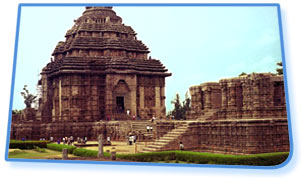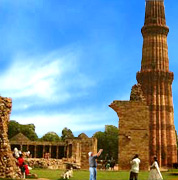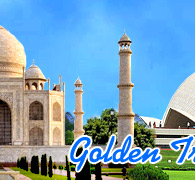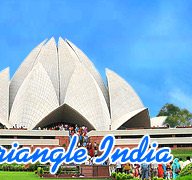Konark, Konark India, Konark Travel, Konark Tours, Travel to Konark, Tourism in Konark, Tour Packages for Konark, Konark Tourism, Konark Pilgrimage Tours, India, Temples in Konark, Konark Temple Tours, Konark Travel Guide.
Konark City

Konark is better known for its Sun Temple dedicated to the Sun God or Surya. A masterpiece of Orissa's medieval architecture, it has been chosen as a
United Nations (UNESCO) World Heritage Site. The city of Konark derives
its name from Konarka, the presiding deity of the Sun Temple. The word
'Konarka' is actually a combination of two words, kona means corner and
arka means sun, and hence, the word 'Konarka' means 'the sun of the
corner'. Once a bustling port with good maritime trade relations with
Southeast Asian countries, Konark was one of the earliest centres of Sun
worshipping in India.
The place has been referred to in the Puranas as Mundira or
Mundirasvamin, a name that was subsequently replaced by Konaditya or
Konarka. Other religious texts also point towards the existence of a sun
temple at Konark long before the present temple. The present Sun Temple
was probably built King Narashimhadev I of the Ganga dynasty to
celebrate his victory over the Muslims. The temple was deserted in the
early 17th century after an envoy of the Mughal emperor Jahangir
desecrated it. However, there is a legend, which says that the temple
was constructed by Samba, the son of Lord Krishna who was afflicted by
leprosy, brought about by his father's curse on him. After 12 years of
penance, Surya, the Sun God, cured him and thus, he built an exquisite
temple in his honor.
| Location: |
In Orissa, India. |
| Significance: |
Known for its Sun Temple. |
| Climate: |
The summers in Konark are extremely hot with temperatures as high as 43oC and the region experiences heavy rainfall between July to September. |
Shopping Attractions:
Stone and Wood carvings of Konark are worth consideration as are the
Patta paintings and the famous applique work of Pipli along with many
other handicrafts of Orissa are sure to be a long-lasting memento of the
delightful trip to the city.
Prime Attractions:
Sun Temple:
The Sun Temple at Konark is a World Heritage Site. King Narasimhadeo
(1238-64 AD) was the chief patron of the Konark Sun Temple. He wanted to
build a shrine dedicated to the Sun God. There are a number of sun
temples in India, but the most magnificent example of the vahana in
India is undoubtedly at Konark. To simulate the appearance of a wheeled
chariot, the longer sides of the platform over which the temple stands
were decorated with a relief of 12 massive, beautifully carved wheels
more than 10 feet (3 meters) in diameter. Each of these giant wheels is
a faithful reproduction of the real thing in stone, complete with
intricately carved hub, spokes, and pins. To complete the illusion of
the solar chariot, colossal freestanding statues of seven galloping
horses were installed before the main entrance. The parapets on either
side of the flight of steps leading to the entrance too are actually a
row of richly caparisoned, life-size prancing steeds straining at their
harness.
The Orissa temples consist of a sanctum, one or more front porches (Jag
Mandir) with pyramidal roofs, a dance hall (Nat Mandir), and a hall of
offerings (Bhog Mandir) apart from the inner shrine (Garbhagriha) where
the deity resides. The Deul (main temple), Jagmandir and Nat Mandir of
the Sun Temple are covered with beautiful sculptural friezes and
carvings. Konark chiefly consists of the chariot called 'the Black
Pagoda' by the British, and its lofty ceremonial hall. The great cube of
masonry forming the temple basement is ornamented with the amazing
freestanding stone wheels. The lowest zone of this base has continuous
elephant and hunting friezes (carved stone panels), among which one
finds intriguing mythological beasts like the Gaja-Singha, a lion riding
an elephant. A series of niches separated by widely projecting pilasters
are full of superb erotic sculpture. The pyramidal roof which rises
above this consists of corbelled vaulting with a pleasantly wavy
curvilinear effect. Three distinct terraces recede to the huge stone
lotus atop the shikhara.
Mayadevi Temple:
To the southwest of the temple, behind the sanctuary, are the remnants
of another temple known as Mayadevi temple. The temple has controversies
as to its conception. While some people think that the temple was
dedicated to one of the Surya's wives, others differ in opinion and
believe it to be an older version of the Surya Temple itself. It is
carved with erotic sculpture, stone carvings of dancing nymphs,
musicians, floral motifs, hunting and court scenes. Twin lions guard the
entrance and on each side of this temple stand an enormous elephant and
a warhorse trampling fallen warriors.
Archaeological Museum:
Just outside the Sun Temple, is the Archaeological Museum that houses
many sculptures and carvings found during the temple excavations. The
stone images of nine planet deities, the Navagrahas, which were
originally set above the temple's ornamental doorways is now kept as a
living shrine. The museum is open throughout the week except Friday.
Konark Beach:
Three kilometers from the temple, is the Konark beach or Chandrabhaga.
Not only a walk on the beach is a plesant experience, people also flock
to the place for a holy dip in the sparkling seawaters and roll in the
white-grained sands. The Black Pagoda (The Sun Temple), the glorious and
majestic edifice, stands frozen with its splendor as the cool blue sea
and the rapid waves roll in and out complementing its serenity.
Konark Dance Festival:
A dance festival is held in an amphitheatre built near the Sun Temple
every year in the month of December. Known as the Konark dance festival,
the event brings together eminent classical dancers of India who perform
various dance forms like Odissi, Bharatnatyam, Manipuri, Kathak and
Chhow. The classical extravaganza is a journey through ecstasy, and a
visit to Konark during this time offers you with a combination of art,
craft, fun and frolic.
Magha Saptami:
Magha Saptami or the Chandrabhaga Mela is actually the Sun Festival
held at Konark on the seventh day of the bright half of the month of
Magha (that usually falls in January or February, according to the Hindu
calendar). During this festival, the pilgrims bathe in the sea before
sunrise and then proceed to the temple to worship.
How To Reach
| By Air: |
The nearest airport is Bhubaneswar,
64 km from Konark, which is well connected to and from Calcutta,
Delhi, Hyderabad, Chennai and Nagpur. |
| By Train: |
The nearest railway stations are Puri at a
distance of 31 km and Bhubaneswar, at a distance of 64 km, which in
turn are well linked by trains to all the major cities of India. |
| By Road: |
Konark has a good network of roads including
National Highway and State Highway that connects it to Puri,
Bhubaneswar and all other major cities in Orissa. |
 Konark is better known for its Sun Temple dedicated to the Sun God or Surya. A masterpiece of Orissa's medieval architecture, it has been chosen as a
United Nations (UNESCO) World Heritage Site. The city of Konark derives
its name from Konarka, the presiding deity of the Sun Temple. The word
'Konarka' is actually a combination of two words, kona means corner and
arka means sun, and hence, the word 'Konarka' means 'the sun of the
corner'. Once a bustling port with good maritime trade relations with
Southeast Asian countries, Konark was one of the earliest centres of Sun
worshipping in India.
Konark is better known for its Sun Temple dedicated to the Sun God or Surya. A masterpiece of Orissa's medieval architecture, it has been chosen as a
United Nations (UNESCO) World Heritage Site. The city of Konark derives
its name from Konarka, the presiding deity of the Sun Temple. The word
'Konarka' is actually a combination of two words, kona means corner and
arka means sun, and hence, the word 'Konarka' means 'the sun of the
corner'. Once a bustling port with good maritime trade relations with
Southeast Asian countries, Konark was one of the earliest centres of Sun
worshipping in India.











